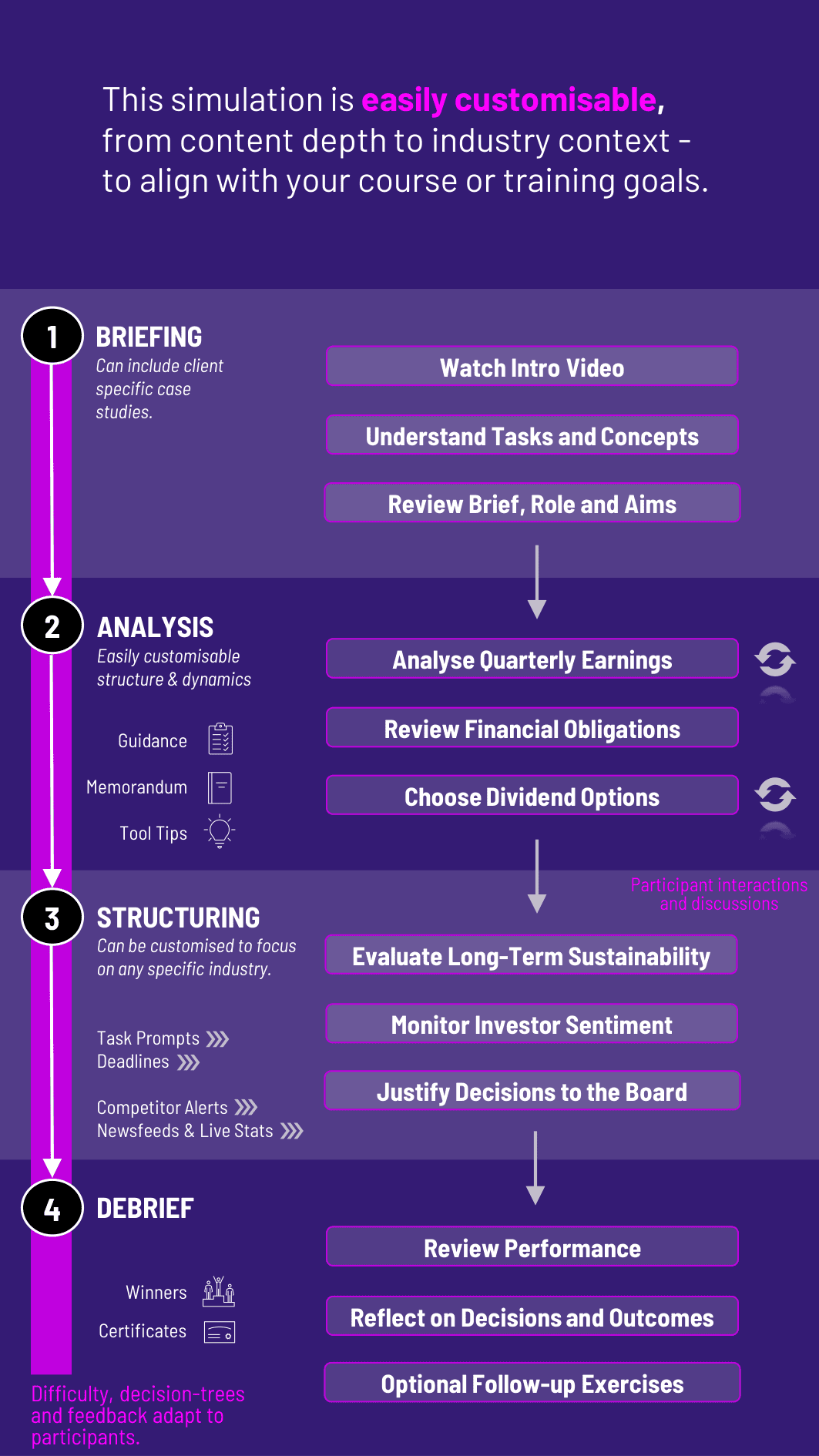
In this hands-on Dividend Policy Simulation, participants act as corporate finance leaders responsible for adapting a company’s dividend strategy responding to pressures from investors, cash flow dynamics, and strategic opportunities.
Dividend Policy Types: Residual, stable, constant payout, hybrid
Shareholder Expectations: Institutional vs. retail investors
Signaling Effect: How dividend changes influence market perception
Cash Flow Management: Balancing liquidity with long-term investment
Alternative Payouts: Buybacks, special dividends, retained earnings
Tax and Regulatory Impact: Jurisdictional considerations and dividend taxation
Investor Relations: Framing dividend decisions to the market
Lifecycle Considerations: Growth phase vs. mature company dividend strategy


Analyze quarterly earnings and cash flows
Review capital expenditure and debt obligations
Choose between dividend options: increase, decrease, suspend, or maintain
Consider issuing share buybacks as an alternative
Evaluate the long-term financial sustainability of their policy
Monitor investor sentiment and stock price reactions
Justify decisions to the board, analysts, and shareholders
Adapt to external shocks such as recession, litigation, or windfall profits
Each round brings new data and context, pushing participants to re-evaluate and iterate their strategy.
By the end of the simulation, participants will:
Understand how dividend policies are formed and evolve
Evaluate the trade-offs between investor expectations and capital needs
Respond to market sentiment and communicate policy decisions effectively
Analyze financials to determine feasible and sustainable payouts
Consider tax and signaling implications of payout decisions
Explore the lifecycle of a firm and its dividend policy alignment
Justify dividend actions to multiple stakeholders with different goals
Navigate external pressure from activist investors or analysts
The simulation is ideal for students studying corporate finance, investor relations, or capital markets - and for early-career professionals preparing for real-world financial decision-making.
1. Review Company Performance Participants receive financial statements, strategic priorities, and capital forecasts.
2. Choose a Dividend Strategy They select a policy approach or make specific dividend payout decisions for the quarter.
3. Model Financial Implications Participants analyze cash flow impacts, debt capacity, and reinvestment trade-offs.
4. Monitor Stakeholder Reactions Market feedback, shareholder sentiment, and analyst coverage reflect the results of their actions.
5. Communicate Decisions Participants write or present a rationale for their decisions to the board, investors, or the media.
6. Adapt Over Time New events (e.g. macro shocks, profit windfalls, investment opportunities) change the game in future rounds.
Do participants need prior finance knowledge? A basic understanding of cash flow and capital structure is helpful but not mandatory.
Does the simulation include tax impacts? Yes. Scenarios can include dividend tax regimes and investor type differences.
Can this be run for corporate finance workshops and courses? Yes. It’s ideal for both academic and professional settings.
Does it simulate real-time market reaction? Yes. Participants see changes in investor sentiment, share price, and stakeholder commentary.
Are share buybacks included? Yes. Participants may choose to distribute capital via buybacks instead of dividends.
How long does the simulation last? It can be delivered as a 2 - 3 hour session or spread over several modules for deeper analysis.
Is it based on real companies? Scenarios are fictional but modeled closely on real industry situations and financial dynamics.
Is the simulation team-based? It can be. Teams may act as finance teams advising the CFO or presenting to the board.
Can we change sectors? Yes. The simulation can be tailored to sectors like energy, consumer goods, or tech.
Is communication assessed? Yes. Participants are evaluated on clarity, strategy alignment, and stakeholder handling in presentations or memos.
Strategic alignment of dividend decisions
Financial accuracy and sustainability
Adaptability to changing business contexts
Communication to internal and external stakeholders
Balancing short-term pressure with long-term goals
Team collaboration and stakeholder negotiation
Deliverables may include policy memos, board presentations, or post-simulation debriefs. Additionally, you can also add a built-in peer and self-assessment tool to see how participants rate themselves. This flexibility allows the simulation to be easily integrated by professors as graded courses at universities and by HR at assessment centres at companies.
Join this 20-minute webinar, followed by a Q&A session, to immerse yourself in the simulation.
or
Book a 15-minute Zoom demo with one of our experts to explore how the simulation can benefit you.